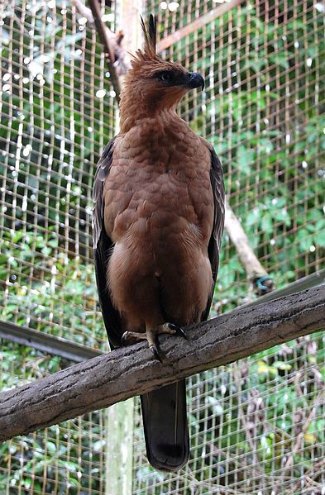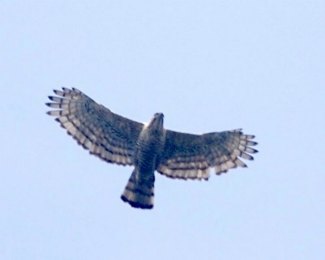Javan Hawk Eagle - Nisaetus bartelsi
By Midori (modified by Arjuno3), CC-BY-SA-3.0, via Wikimedia Commons
Family: Accipitridae
Genus: Nisaetus
Species: N. bartelsi
Javan Hawk Eagles are medium-sized eagles that are endemic to the island of Java in Indonesia. They are currently Endangered, due to habitat destruction, illegal poaching, and capture for the pet trade. They form a clade with Nisaetus alboniger (Blyth’s Hawk Eagle), N. kelaarti (Legge's Hawk Eagle), N. nanus (Wallace’s Hawk Eagle), and N. nipalensis (Mountain Hawk Eagle).
Physical Description:
Javan Hawk Eagles have a dark brown back and chestnut coloring along the sides of the head and the nape; the throat is cream-colored with a dark stripe. The crest is held almost vertically and is black tipped with white. The wings are dark brown, while the long tail is gray-brown with four black bands, the subterminal band being the widest. Underparts are white with rufous barring. The eyes and feet are yellow, and the cere is gray.
Juveniles are similar to adults but have plainer underparts and duller coloring on the head. The tail, instead of the four found in adults, has five black bars. The eyes are blue-gray and turn yellow during their second year.
Their call is a high-pitched whistle. Listen to a Javan Hawk Eagle.
Size:
Length: 60 cm
Habitat and Distribution:
Javan Hawk Eagles live in primary forest, secondary forest, tree plantations, and semi-deciduous forest, and they often soar above the treetops when the weather is clear. They usually occur from 500-1,000 meters above sea level but they have been recorded almost at sea level and as high as 3,000 m.
As their name indicates, they are endemic to the island of Java, from 6°S to 8°S. Limited to remaining patches of forest, they are scarce within their range—there are an estimated 600-900 individuals, over 14,500 km². Adults are sedentary, though juveniles disperse from their breeding areas.
By Wibowo Djatmiko, CC-BY-SA-3.0, via Wikimedia Commons
Diet and Hunting:
Javan Hawk Eagles eat small mammals, birds, snakes, and lizards. Mammals are their preferred prey, which includes tree shrews, squirrels, bats, rats, and other rodents.
They usually hunt from a perch, but have been observed swooping down to catch prey on a tree or on the ground.
Reproduction:
The breeding season is from May-August, though breeding has been recorded year-round.
The nest is made out of sticks and lined with green leaves, and placed in a large tree in undisturbed forest. One egg is laid and incubated for 47-48 days. Fledging takes 68-72 days, with both parents feeding the young. Pairs breed every two years if nesting is successful, since juveniles may remain close to the nest for a year after they fledge.
Conservation:
Javan Hawk Eagles are threatened by habitat destruction in the form of conversion to agriculture, development, and uncontrolled fire. They are also in danger from illegal poaching and capture for the pet trade; around 30-40 birds are reported in the trade each year, and it is assumed many more go unreported. Despite the fact legislation passed in Indonesia banning poaching and capture, in addition to declaring the Javan Hawk Eagle Indonesia’s National Rare/Precious Animal, those actions have only increased interest in the species as pets. They are currently listed as Endangered by BirdLife International.
Conservation measures already undertaken include surveys into the birds' distribution and ecology and strict legislation, although the latter is often ineffective due to lack of enforcement. An action plan has been created and conservation awareness programs begun, from radio broadcasts and school visits to nest protection programs. Conservation measures proposed include implementing the Javan Hawk-Eagle Recovery Plan, continuing ecological studies, improving management of protected areas, searching for and guarding nests close to human populations, enforcing legislation, and continuing/expanding efforts to gain public support for conservation.
By Lip Kee, CC-BY-SA-2.0, via Wikimedia Commons
Taxonomy:
Nisaetus bartelsi was formerly placed in genus Spizaetus, but molecular studies done on one nuclear and two mitochondrial genes have shown that Asian hawk eagles are separate from New World hawk eagles (currently classified as Spizaetus) and should therefore be placed in the new genus Nisaetus. N. bartelsi forms a clade with N. alboniger (Blyth’s Hawk Eagle), N. kelaarti (Legge's Hawk Eagle), N. nanus (Wallace’s Hawk Eagle), and N. nipalensis (Mountain Hawk Eagle).
Other Names:
Java Hawk Eagle, Orel jávský (Czech), Javahøgeørn (Danish), Javaanse Kuifarend (Dutch), Jaava tuttkotkas (Estonian), Jaavanjalokotka (Finnish), Aigle de Java (French), Javaadler (German), Elang Jawa (Indonesian), Spizaeto di Giava (Italian), Jawakumataka (Japanese), Wojownik jawajski (Polish), Águila-azor de Java (Spanish), Javaörn (Swedish).
Heraldry:
The Javan Hawk Eagle is Indonesia's National Bird.
Other Multimedia:
None available.
References:
http://avibase.bsc-eoc.org/species.jsp?avibaseid=A4AB4FBAA86DACAB
BirdLife International (2011) Species factsheet: Nisaetus bartelsi. Downloaded from http://www.birdlife.org on
24/12/2011.
Global Raptor Information Network. 2011. Species account: Javan Hawk-eagle Nisaetus bartelsi. Downloaded from
http://www.globalraptors.org on 24 Dec. 2011
BirdLife International 2008. Nisaetus bartelsi. In: IUCN 2011. IUCN Red List of Threatened Species. Version 2011.2.
www.iucnredlist.org. Downloaded on 24 December 2011.
http://www.planetofbirds.com/accipitriformes-accipitridae-javan-hawk-eagle-nisaetus-bartelsi
Ferguson-Lees, James, and Christie, David A. Raptors of the World. Houghton Mifflin Company, 2001.
http://www.thejakartapost.com/news/2011/05/28/javan-hawk-eagle-endangered.html


